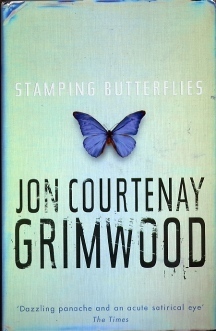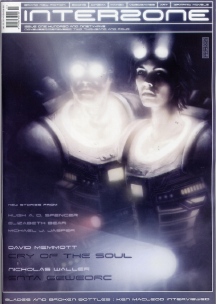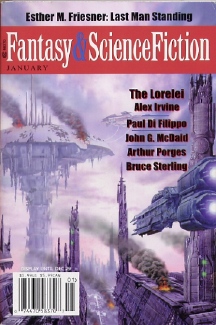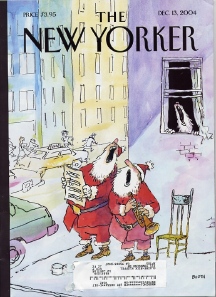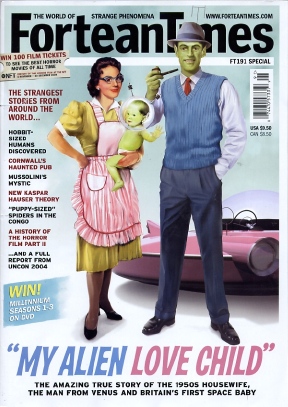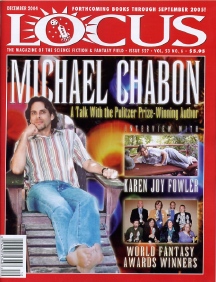Ephemeral Pleasures
One Month of Magazine Reading
The Agony Column for Some Damn Date Near the End of 2004
Commentary by Rick Kleffel
One Month of Magazine Reading
The Agony Column for Some Damn Date Near the End of 2004
Commentary by Rick Kleffel
But in genre fiction, the short story still holds a lot power. I subscribe to The Magazine of Fantasy and Science Fiction, The Third Alternative and Interzone, as well as the The New Yorker, Locus, and The Fortean Times. F&SF comes closest to being cheap -- it's $4.50 per issue. But when you write out a check for an annual subscription to these magazines, well, you want to get you money's worth. You'd think that would mean reading them cover to cover, but that's not exactly what I've been doing, until this month, when I decided that if I were going to write a comprehensive review of the magazines, I'd best do a comprehensive, obsessive, cover-to-cover reading. At first I was just going to read F&SF and Interzone, but last week's New Yorker grabbed my attention with an article about fantasy icon Lord Dunsany, and I found myself reading that obsessively as well. The plan -- pretty much adhered to -- was to read an article from one magazine, then the next then the next. Now I can’t say I read the entire issue of Locus cover-to-cover, simply because they review a lot of books that are in my inbox, and I don’t read reviews of books I'm going to read and review to ensure that I don't end up simply regurgitating -- even unconsciously -- what someone else said.
So I stacked up the magazines and started reading. First in my queue was Alexander Irvine's 'The Lorelei' from F&SF. Readers know that I'm a fan of Irvine's. I thought his first novel, 'A Scattering of Jades' was an excellent work and I look forward to reading his most recent novel, 'One Soldier, One King'. On the other hand, I hadn’t liked his last science fiction story in F&SF. This time around though, the signs were more propitious. 'The Lorelei' was set in the same nineteenth century New York portrait painting scene as Jeffrey Ford's 'The Portrait of Mrs. Charbuque'. So Irvine had returned to the same century he'd dealt with so well in 'A Scattering of Jades'. Moreover, the story itself told of a young painter who happens to meet up with Albert Pinkham Ryder, one of the more interesting real painters who showed up in Ford's novel. The prose was very nicely turned, and the characters were deftly portrayed. But for me, the supernatural lynchpin of the story was a little too blurry. Though Irvine had done an outstanding job at scene-setting, in the end I felt like I missed something. I'd certainly commend F&SF, however, for publishing a story I might hope to find in The New Yorker, if The New Yorker were in one of its occasional "genre fiction is OK with us" moods. I wonder whether I would have liked it better in a more literary setting. Hmm.
Then I popped over to The New Yorker, where I read 'Minor Magus' by Laura Miller of Salon.com. This was the article that had made me open up and pay attention to this week's issue. Opposite a full-page, four-color advertisement for the latest Annie Proulx collection of short stories, Miller gives an entertaining and illuminating look at the life and writing of Edward John Moreton Drax Plunkett, better known to fantasy readers as Lord Dunsany. Like many of my readers (I presume), I cut my fantasy-reading teeth on the 1970's mass-market paperback editions of his work, published by Ballantine Books under their Adult Fantasy imprint and edited by Lin Carter. Miller gives a fascinating look at the life and writing of this fantasy icon, one of the writers revered by H. P. Lovecraft. For any reader of Dunsany, Lovecraft or fantasy, this article provides a great look at a peculiar creative life. Plus, she gets bonus points for mentioning one of my favorite stories by Dunsany, 'Idle Days on the Yann'. She even talks about Night Shade books recent release of the 'The Collected Jorkens', and gives the stories within a rather positive review. When I sent email to Jason over at Night Shade congratulating him, he seemed rather bemused by all the coverage. But I say more power to them -- and a hearty thanks to Miller, who wrote a compelling article about a major name in obscure fiction circles for a major literary publication.
Then it was back to Interzone for 'Problem Project' by Hugo A. O. Spencer. I liked this story a lot. It had humor, it was really weird, it was broken into little segments that were fun to read and made the single-sitting reading very enjoyable. This was a wonderful little slice of surreal SF. Meanwhile, back at F&SF, I read the most entertaining book reviews by Charles De Lint and Elizabeth Hand. Since they both write great books, it stands to reason that their book reviews are well-worth reading. Noted author Arthur Porges handed in a one-pager titled 'Born Bad' that frankly didn’t leave much of an impression. But then, The New Yorker beckoned.
The Trinity Foundation takes its name not from the Father, etc, but rather from Anthony's time working for the Air Force from 1956 to 1968, when he set up seismographs and other equipment to detect nuclear explosions. In the summer of 1958, Anthony was in the Marshall Islands, trying to calibrate his equipment against what Air Force estimated to be a 3.5-megaton nuclear explosion. "...but it was equal to 9.3 megatons instead. Standing on the shore of an island thirty miles away, Anthony watched the target island disintegrate in a blinding flash. A few second later, the blowback hit him -- a shock wave of wind and sound so powerful that it knocked him into the water." The rest of the article details Anthony's fascinating journey through the hardscrabble world of Christian broadcasting. Now he and his crew investigate other Christian broadcasters, and their results have become the basis for lawsuits, news stories, and television exposés. Rest assured that this is a stellar piece of writing, and that Anthony rises up above the reader like some iconic character from a Flannery O'Connor story. I couldn't put it down, regretted finishing it, and have re-read portions because the writing and the story are so strong. Don’t miss it. It was hard, I admit, and not entirely fair to jump from something like the story of Ole Anthony to Interzone. But that magazine has such a different vibe that it really held its own. Their interview with SF writer Ken Macleod pinned down a personality from the SF world that can come close to keeping up with Ole Anthony. Followed by Michael Jasper's 'Redemption, Drawing Near', Interzone once again drew me into the peculiarly teenaged world of middle-aged men reading about aliens. In this case, the aliens arrive on earth and it proves that a priest will hold the key to communicating with them. As with the other stories in this issue of Interzone, 'Redemption, Drawing Near' effectively cast me into a science-fiction reading haze. Yes, I did notice a couple of words missing, but the story was strong enough to flow past them. It didn't cover new ground, exactly, but it covered old ground gracefully. I felt like I was reading genuine, gosh-wow science-damn fiction and enjoying it.
So, then, back to F&SF. I enjoyed the hell out of Paul DiFillipo's 'Plumage from Pegasus' even though I can’t say for sure whether it was an article or a story. Then finally, I was up to that point in the magazine when what I considered a sure thing was up to bat. That would be Bruce Sterling. Now, I'm sorry Bruce, they're going to call everything you ever write in the future blankpunk, and I'm sure you’re used to it. But 'The Blemmye's Stratagem' is nothing less than stellar, wild, hairy-eyed fantasy set in some sort of alternate Crusaders history -- I don't know, I'm not a Crusades historian, though the story made me wish I was. It also made me look up the word in the title on the Internet, and I was glad I did. You want to give Ole Anthony a run for his money, folks? Hire up Sterling to write something so weird, so wild, so over-the-top that you'll feel like the scorpions are coming out of your brain. But, oh, where is JK Potter when you need him? Hopefully, on a gig for The New Yorker. They need him.
By this time, the following week's New Yorker is out, once again featuring a must-read article from the "Reporter at Large". This week it's David Grann's 'Mysterious Circumstances', about the death of a Holmes scholar. And coincidentally, I'm sure, since I was talking about being a Crusades historian, Joan Acocella writes about two books that re-examine and de-define the crusades in 'Holy Smoke'. Look New Yorker, how fast do you think I can read? Or do you just expect that The New Yorker is all we read? Probably the latter. And while that may not be a bad deal, oh, the hubris, the hubris. What could ever sting like this? So we jump over to F&SF. There it is. Esther Friesner's 'Last Man Standing', another damn fantasy. I'm thinking to myself, "This is the magazine of Fantasy and just a smidgeon of Science Fiction, and I don't want to read something by Esther Friesner. Fantasy schmantasy, priests, warriors, 'Great king's burials' and great Caesar's goddamned ghost!" But, I sigh, I suck in it, and start...only to find myself captivated by some of the best comedic writing I've encountered yet. 'Last Man Standing' was an outstanding finish to F&SF, and regrettably, Friesner goes into my list of authors to seek out. I mean, anyone who makes me laugh out loud deserves my money. This tale of a clever slave is chock full of witty dialogue -- think P. G. Wodehouse does Robert E. Howard. No shouting at the typewriter! With that strong a finish, I was a little bit worried about how Interzone would fare. But the final two stories covered both ends of the spectrum. Elizabeth Bear contributes the issue's long-title story (apparently they're de rigueur) 'When You Visit the Magoebaskloof Hotel, Be Certain Not to Miss the Samango Monkeys'. It was worth every word of the title and more. Bear's story of life on our world and others is powerful fiction, pure and simple, that just happens to be set in the future. And, in part, on another planet. Great illustrations by Josh Finney could only be improved by a full four-color printing that I'd happily pay for. Bear has a new novel coming out next year, 'Hammered' and it's definitely on my hot list. My contact over at Random House describes it as "gritty SF", and this story really whets my appetite. Hey is Interzone doing just what a great magazine does? Yep, damn it. Now I want to read more.
Any doubt that Interzone is going to move away from the SF feel that I suspect its fans expect should be banished by this issue. This is solid SF, through and through. It might not always break new ground, in this particular issue, but that's not a problem. I'll mention in passing that it was universally easy-to-read, no font/background problems, all that banished. It was just an immersive SF reading experience. Overall, the quality was pretty consistent. I really enjoyed the insistent tug of science fiction here. I guess there was something of a Golden Age emotion running through this issue for me. I can't say that this was planned -- but that was my experience. F&SF was not quite as consistent in tone. I never found myself in a goo-goo-gaa-gaa state as I did reading Interzone. Each story was more discrete. There was a wider variety, and that worked well. Still, one clearly can get anything in this magazine. Every issue is unknown territory, which is both a blessing and a curse. And finally The New Yorker. Or, The New Yorkers. Well, lots of damn fine writing in there. Make you feel all grown up and stuff. And to be sure, there's lots to be said for growing up. (Or, at least, pretending to feel that way.) But how many do I read? How fast can I read?
And, ah The Fortean Times. Is there a pleasure as sublime? The gorgeous cover illustration by Alexander Tomlinson is matched by an equally loopy story. How can you not subscribe? I mean, "Puppy Sized" spiders in the Congo? A susbstantial and fascinating article on 'Mussolini's Mystic' that might be part of an alternate-universe New Yorker? Or was it in The New Yorker? Damn experiment in magazine reading. The upshot of it is that more pages get shuffled to the inbox. I found out I like reading magazines. Still, it's kind of like a vacation. Eventually, as I slip through the pages of the latest Jon Courtenay Grimwood novel, I realize while you’re doing it it's fun. But in the end, it only makes you appreciate home more. |
